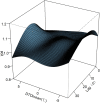Association between the temperature difference and acute exacerbations of chronic obstructive pulmonary disease: A time-series analysis with 143,318 hospital admissions in Beijing, China
- PMID: 36778544
- PMCID: PMC9909227
- DOI: 10.3389/fpubh.2023.1112926
Association between the temperature difference and acute exacerbations of chronic obstructive pulmonary disease: A time-series analysis with 143,318 hospital admissions in Beijing, China
Abstract
Purpose: Acute exacerbation of chronic obstructive pulmonary disease (AECOPD) has the adverse influence on quality of life and creates significant healthcare costs. However, there were sparse studies investigating the correlation between AECOPD hospital admissions and temperature change. Therefore, it is noteworthy to investigate the impact of various temperature differences and recognize the susceptible population. The purpose of this study was to investigate the impact of temperature differences on AECOPD hospital admissions, and to give potentially helpful material for disease preventative efforts.
Methods: The distributed lag non-linear model was adopted to characterize the exposure-response relationship and to assess the impact of temperature difference. The stratified analysis and sensitivity analysis were also conducted to determine the susceptible populations and examine the robustness of the results.
Results: There were 143,318 AECOPD hospital admissions overall during the study period. The AECOPD hospital admissions had significant association with the daily mean temperature difference (DTDmean) such as the extreme-cold temperature difference (1st DTDmean), the ultra-cold temperature difference (5th DTDmean), the ultra-hot temperature difference (95th DTDmean) and the extreme-hot temperature difference (99th DTDmean). Besides, there was the "U-shaped" association between DTDmean and 21 days cumulative relative risk of AECOPD.
Conclusion: The AECOPD hospital admissions was correlated with the DTDmean temperature differences, especially the extreme-cold and extreme-hot temperature difference. Moreover, people older than 65 years were more susceptible to the extreme-hot and extreme-cold temperature difference.
Keywords: AECOPD; distributed lag non-linear model; temperature; temperature change; temperature difference.
Copyright © 2023 Fu, Liu, Zhao, Chen, Chang, Xu, Huang and Fan.
Conflict of interest statement
The authors declare that the research was conducted in the absence of any commercial or financial relationships that could be construed as a potential conflict of interest.
Figures





Similar articles
-
Effects of Ambient Temperature on Acute Exacerbations of Chronic Obstructive Pulmonary Disease: Results from a Time-Series Analysis of 143318 Hospitalizations.Int J Chron Obstruct Pulmon Dis. 2020 Jan 29;15:213-223. doi: 10.2147/COPD.S224198. eCollection 2020. Int J Chron Obstruct Pulmon Dis. 2020. PMID: 32099346 Free PMC article.
-
Assessing the impact of temperature on acute exacerbation of chronic obstructive pulmonary disease hospitalizations in residents of Panzhihua City: a multi-districts study using a distributed lag non-linear model.BMC Public Health. 2024 Aug 8;24(1):2151. doi: 10.1186/s12889-024-19677-2. BMC Public Health. 2024. PMID: 39112974 Free PMC article.
-
Short-term effects of cold spells on hospitalisations for acute exacerbation of chronic obstructive pulmonary disease: a time-series study in Beijing, China.BMJ Open. 2021 Jan 6;11(1):e039745. doi: 10.1136/bmjopen-2020-039745. BMJ Open. 2021. PMID: 33408200 Free PMC article.
-
Pulmonary rehabilitation for patients with acute chronic obstructive pulmonary disease exacerbations: is the evidence strengthening?Curr Opin Pulm Med. 2018 Mar;24(2):147-151. doi: 10.1097/MCP.0000000000000453. Curr Opin Pulm Med. 2018. PMID: 29210749 Review.
-
Recovery Following Acute Exacerbations of Chronic Obstructive Pulmonary Disease - A Review.COPD. 2019 Feb;16(1):93-103. doi: 10.1080/15412555.2019.1598965. Epub 2019 May 2. COPD. 2019. PMID: 31044644 Review.
Cited by
-
COPD risk due to extreme temperature exposure: combining epidemiological evidence with pathophysiological mechanisms.EBioMedicine. 2025 Jun;116:105731. doi: 10.1016/j.ebiom.2025.105731. Epub 2025 Apr 30. EBioMedicine. 2025. PMID: 40311422 Free PMC article. Review.
References
-
- Adeloye D, Song P, Zhu Y, Campbell H, Sheikh A, Rudan I. Global, regional, and national prevalence of, and risk factors for, chronic obstructive pulmonary disease (COPD) in 2019: A systematic review and modelling analysis. Lancet Respir Med. (2022) 2022:7. 10.1016/S2213-2600(21)00511-7 - DOI - PMC - PubMed
-
- GBD . Global, regional, and national deaths, prevalence, disability-adjusted life years, and years lived with disability for chronic obstructive pulmonary disease and asthma, 1990-2015: a systematic analysis for the Global Burden of Disease Study 2015. Lancet Respir Med. (2017) 5:691–706. 10.1016/S2213-2600(17)30293-X - DOI - PMC - PubMed
Publication types
MeSH terms
LinkOut - more resources
Full Text Sources
Medical

